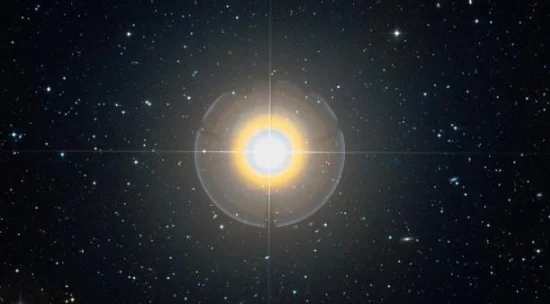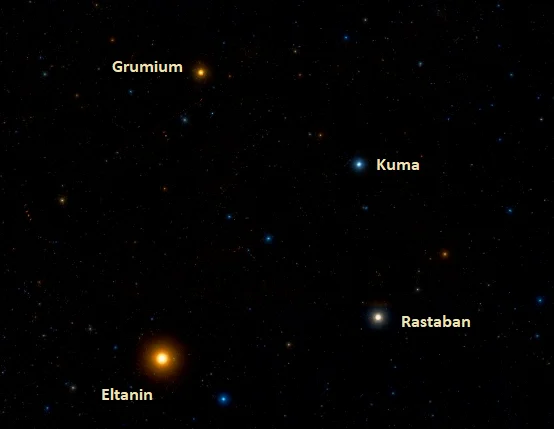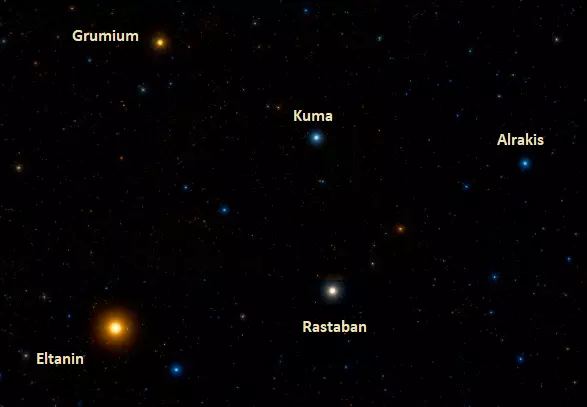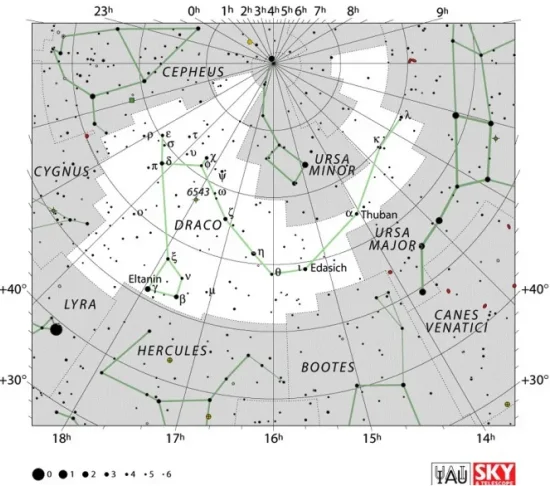Rastaban, Beta Draconis A (β Dra A) is a yellow supergiant or bright giant in a binary star system located about 380 light years away in the northern constellation Draco. With an apparent magnitude of 2.79, it is the third brightest point of light Draco, after Eltanin and Athebyne. Rastaban is recognizable as one of the four stars outlining the head of Draco. Together with the brighter Eltanin, it marks the Dragon’s eyes.
Star system
The Beta Draconis system is composed of Beta Draconis A, a luminous supergiant or bright giant star, and Beta Draconis B, a much fainter dwarf star. The two components are separated by 4.2 arcseconds and have an orbital period of about 4,000 years.
Rastaban, Beta Draconis A, is a spectral standard for its class. It has the stellar classification G2Ib-IIa, indicating a yellow supergiant or bright giant. It has a mass six times that of the Sun and, as it evolved away from the main sequence, it has swelled to a size 40 times solar. The star’s estimated age is 65 million years.

Rastaban (Beta Draconis), image: Wikisky
With a surface temperature of about 5,160 K, Rastaban is 996 times more luminous than the Sun. It spins faster than our star, with a projected rotational velocity of 10.7 km/s.
Even though it is a young star, Rastaban has burned through the supply of hydrogen in its core relatively quickly due to its high mass and will not have a very long life. It is not massive enough to go out as a supernova. Instead, when it reaches the end of its life cycle, it will puff away its outer layers to form a planetary nebula and slowly fade away as a white dwarf.
Facts
The Beta Draconis system is moving toward us with a radial velocity of -20.825 km/s.
Rastaban has been observed to vary in brightness by only a hundredth of a magnitude even though it lies on or near the Cepheid instability strip, which is populated by Cepheid variables like Polaris in Ursa Minor and Mekbuda in Gemini. In this respect, Rastaban is similar to the Aquarius supergiants Sadalsuud and Sadalmelik, which also do not vary in brightness. The reason why these stars do not vary (or at least not with a greater amplitude) is still unknown.
Rastaban forms the Head of Draco with the orange giants Eltanin (Gamma Draconis), Grumium (Xi Draconis), and the white main sequence star Nu Draconis, traditionally known as Kuma.

The Head of Draco, image: Wikisky
Name
The name Rastaban (pronunciation: /ˈræstəbæn/) comes from the Arabic phrase ra’s ath-thu’ban, meaning “the head of the serpent.” The name refers to the star’s position in the constellation Draco, marking the celestial dragon’s head. The word thu’ban, which gives Draco’s Alpha star its name (Thuban), denotes a large snake.
The name Rastaban was approved by the International Astronomical Union’s (IAU) Working Group on Star Names (WGSN) on August 21, 2016. It formally applies only to the component Beta Draconis A.
Beta Draconis was also traditionally known as Asuia and Alwaid. Alwaid comes from the Arabic Al’ Awai’d (the Mother Camels), an asterism formed by Rastaban with Eltanin (Gamma Draconis), Grumium (Xi Draconis), Kuma (Nu Draconis) and Alrakis (Mu Draconis). In Latin, the asterism was called Quinque Dromedarii, the Five Camels (Dromedaries).

The Mother Camels asterism, image: Wikisky
Location
Rastaban is very easy to identify because it is part of a relatively bright asterism, the Head of Draco. It can be found using the bright stars of the Northern Cross in Cygnus. A line extended from Sadr, the central star of the Cross, through Fawaris at the wing of Cygnus leads first to Eltanin and then to Rastaban. Both the Northern Cross and the Head of Draco can be seen high overhead in the evening during the northern hemisphere summer.

The location of Eltanin and Rastaban, image: Wikisky
Constellation
Rastaban is located in the constellation Draco. Draco is one of the 48 Greek constellations, first listed by Ptolemy of Alexandria in his Almagest in the 2nd century CE. The constellation is associated with Ladon, the dragon that guarded the gardens of the Hesperides in Greek mythology.
With an area of 1,083 square degrees, Draco is the eighth largest constellation in the sky and the fourth largest constellation in the northern celestial hemisphere. It is circumpolar, never setting below the horizon for northern observers. It can be seen winding around Polaris and Ursa Minor throughout the year. For most observers south of the equator, the constellation never rises above the horizon.

Draco constellation map by IAU and Sky&Telescope magazine
Draco hosts several notable deep sky objects. These are the Spindle Galaxy (NGC 5866), a lenticular galaxy that was probably the object that Charles Messier catalogued as M102, the Tadpole Galaxy (Arp 188), a disrupted barred spiral galaxy known for its long tail of stars, the Draco Dwarf Galaxy, one of the Milky Way’s faintest satellites, the massive galaxy cluster Abell 2218, and the Cat’s Eye Nebula (NGC 6543), a bright planetary nebula that appears in the same wide field of view as the barred spiral galaxy NGC 6552.
Draco is also home to many interesting stars. These include the orange giant Eltanin (Gamma Draconis), the white giant Thuban (Alpha Draconis), the yellow giants Athebyne (Eta Draconis) and Omicron Draconis, and the multiple star system Mu Draconis (Alrakis).
The best time of year to see the stars and deep sky objects in Draco is during the month of July, when the constellation is high overhead in the evening. The entire constellation is visible from locations between the latitudes 90° N and 15° S.
The 10 brightest stars in Draco are Eltanin (Gamma Dra, mag. 2.23), Athebyne (Eta Dra, mag. 2.73), Rastaban (Beta Dra, mag. 2.79), Altais (Delta Dra, mag. 3.07), Aldhibah (Zeta Dra, mag. 3.17), Edasich (Iota Dra, mag. 3.29), Chi Draconis (mag. 3.57), Thuban (Alpha Dra, mag. 3.6452), Grumium (Xi Dra, mag. 3.75), and Giausar (Lambda Dra, mag. 3.85).
Rastaban – Beta Draconis
| Spectral class | G2Ib-IIa |
| U-B colour index | +0.954 ± 0.007 |
| B-V colour index | +0.98 |
| R-I colour index | +0.48 |
| Apparent magnitude | 2.79 |
| Absolute magnitude | -2.457 |
| Distance | 380 ± 4 light years (117 ± 1 parsecs) |
| Parallax | 8.58 ± 0.10 mas |
| Radial velocity | -20.825 ± 0.0022 km/s |
| Proper motion | RA: −15.89 ± 0.09 mas/yr |
| Dec.: +12.28 ± 0.11 mas/yr | |
| Mass | 6.0 ± 0.2 M☉ |
| Luminosity | 996 L☉ |
| Radius | 40 R☉ |
| Temperature | 5,160 ± 150 K |
| Metallicity | 0.02 ± 0.10 dex |
| Age | 65 million years |
| Rotational velocity | 10.7 km/s |
| Surface gravity | 1.86 ± 0.04 cgs |
| Constellation | Draco |
| Right ascension | 17h 30m 25.9616959s |
| Declination | +52° 18′ 04.999351″ |
| Names and designations | Rastaban, Beta Draconis, β Dra, 23 Draconis, Alwaid, Asuia, HD 159181, HR 6536, HIP 85670, SAO 30429, FK5 653, PPM 36022, GC 23741, GCRV 10127, PLX 3982.00, BD+52°2065, AG+52 1139, UBV 14948, IRAS 17292+5220, 2MASS J17302597+5218051, JP11 2863, TYC 3521-1800-1, Gaia DR2 1415230383033121024, ADS 10611, WDS 17304+5218AB, CCDM J17305+5218, IDS 17282+5223 |